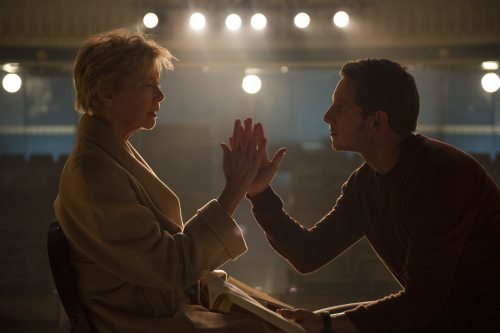
Susie Allnutt/Sony Pictures Classics
MOVIE REVIEW
Film Stars Don't Die in Liverpool (2017)
This understated and affecting film signs off with its subject, golden-age screen star Gloria Grahame (played by Annette Bening), picking up a Best Supporting Actress Oscar for her part in “The Bad and the Beautiful.” Grahame makes just a brief visit to the stage – appropriate enough as she was only in the film for nine minutes – expresses thanks and slips off stage right. Given that this archive footage is the last thing we see before the credits roll, one could see it as a subliminal message drumming up support amongst Academy voters for Ms. Bening’s brilliant portrayal of the older Grahame. One can hardly begrudge her this shout out. Four nominations and not one golden boy on the shelf, not to mention being cruelly overlooked for her bravura turn in “20th Century Women.”
One of Grahame’s most famous roles was in Fritz Lang’s “The Big Heat” where she took a pot of hot coffee to the kisser, leaving an indelible scar on her character’s face and the memories of cinema goers. Decades later in 1990, Ms. Bening based her breakthrough role as Myra in “The Grifters” on Grahame’s performance in “The Big Heat.” Grahame also starred as Humphrey Bogart’s neighbor in “In a Lonely Place,” played the flirtatious Violet in the evergreen “It’s A Wonderful Life” and was the girl who couldn’t say “no” in the movie version of “Oklahoma.”
“Film Stars Don’t Die in Liverpool” is no nostalgia trip. There are brief glimpses of the real Grahame and throwaway references to Bogie and Lauren Bacall as well as the director Nicolas Ray, No. 2 of four husbands. The Grahame portrayed in “Film Stars Don’t Die in Liverpool” is some distance from her Oscar glory. Age, illness and difficult behavior have sent Grahame back to her theatrical roots and we first encounter the actress running through vocal exercises prior to a performance of “The Glass Menagerie.”
In 1979, Grahame was working in London where she shared an apartment building with Peter Turner (Jamie Bell) an actor-waiter from Liverpool. Mr. Turner, upon whose memoirs the film is based, helped Grahame run through her lines, disco danced in the star’s living room and eventually ended up sharing her bed. At 29, he was more than two decades younger than his lover and generally naïve about her screen idol past. In the movie, the local pub landlord knows far more about Grahame’s filmography than Mr. Turner does.
The young actor had fallen for the genuine Grahame rather than the shining, sepia dream that had bewitched so many people in darkened movie theaters. However, the life Grahame showed Mr. Turner – where Liza Minelli might show up out of the blue or, amazingly, you could actually have pizza delivered to your house – left him astonished. Their time together was not always a Hollywood dream come true. Mr. Turner could be suspicious of Grahame’s fidelity while the actress fretted about her age and supposedly fading looks – she still hoped to play Juliet – and was insecure about the legitimacy of the relationship. Yet, she could also be strong, sexually confident and was finally brave enough face the cancer that would eventually kill her without bothering her children or her lover.
The film is at its best when the ailing Grahame becomes a houseguest to Mr. Turner’s parents in Liverpool. Mother Turner is played by the generally wonderful Julie Walters, here reunited with her “Billy Elliot” costar Mr. Bell after 17 years. Grahame’s stay at Chez Turner is almost as incongruous as Paddington Bear moving in with the Browns but she is welcomed and accepted none the less. Mother Turner fusses over her new lodger’s needs, lending her a pair of thermal underwear and canceling a trip to visit a son in Australia so that she can nurse Grahame in her final days.
In the hands of the Turners, Grahame found a familial security that had been lacking from her wrecked marriages, pushy mother or bitchy sister. Despite some protestations from Mr. Turner’s brother – played by an amusingly coiffured Stephen Graham – the star that had fallen to Earth became part of the Turner brood. At least until it became clear that the right thing to do was to contact Grahame’s children. “Film Stars Don’t Die in Liverpool” is a love story in the purest form where people are willing to do the right thing for those they care about, even though it may cause them pain. The last 20 minutes of the movie will likely cause a lacrimal hemorrhage in many viewers but what they will be weeping over is genuinely touching.
The film’s director Paul McGuigan has had mixed results in his career. “Gangster No. 1” was pretty good but “Victor Frankenstein” was terrible. He does a nice job here in evoking period and the action moves seamlessly back and forth in time. A household door opens to lead us into another place and time entirely. Peter Turner walks down a corridor in Liverpool, 1981, and arrives in London two years earlier. A spat between the two lovers is depicted twice, once from Mr. Turner’s viewpoint and then from Grahame’s after we have learned the reasons behind her seemingly odd behavior.
“Film Stars Don’t Die in Liverpool” covers a brief period in the tempestuous and remarkable life of Gloria Grahame but it’s a great story anyway. The performances are strong all round but it’s really Ms. Bening’s movie. If she does end up with the Oscar for her work here one imagines that, unlike Grahame, she will take her time on stage. She deserves it after all.
Comments